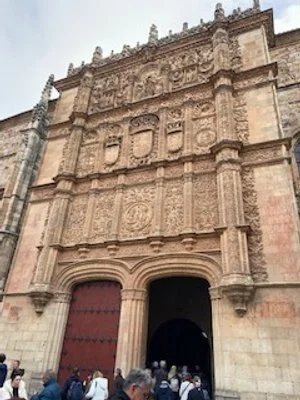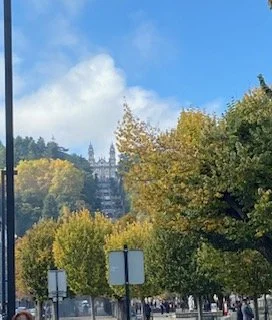#63 Tripping into Spain
Part 3 of my trip to Portugal
At Vega Terron, in Spain, we exited the docked ship and boarded buses for the two-hour trip to Salamanca. Called the “Golden City” because of the appearance of the ubiquitous sandstone buildings. The city was named a UNESCO World Heritage Site.
We took a walking tour of the city on a gray morning. Our first stop was the historic market building with multiple fish, meat, cheese and produce sellers. There was no touristy food hall here as there was in in Lisbon. The town center was designed in the style of the central square of Madrid and was filled with vendors for a market day. The arcade around the perimeter allowed us to dodge the rain.
Salamanca boasts one of the world’s oldest universities. It was founded in 1218 by King Alfonso IX. It is the oldest university in the Hispanic world and one of the oldest in the world and has over 30,000 students. The ornate stone façade of the original university center features carving and tracery. Like every standard college tour, it ends at the book store. One can pick up his own University of Salamanca hoodie or T-shirt.
Facade at Universidad de Salamanca Photo by Joan Naidorf
We convened at a local hotel where all the tour members had a paella lunch in the dining room. A Flamenco group entertained us with recorded music and the famous Spanish folk dancing. Two female dancers were joined by a percussionist using a Cajón, which means a box or drawer. The instrument originate in Peru and the player sits on it. It is played with the hands, fingers, brushes and even feet. The Flamenco group put on a spirited show.
Flamenco Dancer photo by Joan Naidorf
After a little free time to explore Salamanca, we boarded the busses and drove the 2 hours back to our ship. This provided ample time for the cherished Spanish tradition of the siesta. The ship, AMADouro, had repositioned back to the Portuguese side of the Douro River. We enjoyed the meal that they called the Grand Portuguese Dinner featuring regional treats.
Our trip to the city of Vila Real to visit the Mateus Palace was scuttled due to unforeseen circumstances on the river. Some debris had collected in one of the river locks and the ship had to dock for an hour or two to allow for removal and the all clear sign. We stayed on the ship, learned more about wine, and relaxed while the captain and the crew tried to get us back on schedule.
The next day, we boarded the busses to visit the town of Lamego and the Sanctuary of Our Lady of Remedies. The famous church is a famous pilgrimage site where the faithful would visit to appeal for healing. The hardy pilgrims take 686 stairs up to the church but our motor coach will gladly drive us to the top. The ornately decorated church is well worth the effort and a peek inside.
After our visit we convened at a local restaurant to taste a local sparkling wine and the local treat: bolas. During some free time, we were able to find some nice souvenirs before the trip back to a special luncheon at the Quinto Pacheco
The vineyard has a glass enclosed restaurant where we enjoyed lunch and tasted some vintage port. This vineyard is well known for guest rooms that occupy re-purposed huge wooden port wine barrels. The weather was warm and the terraced vineyards provided views of the sun-dappled rows of vines. The lunch at Quinta de Pacheca was one of the best meals that we had while off the ship.
Quinto de Pacheco photo by Joan Naidorf
On the Wednesday evening, we an adorable presentation of a local singing group, The Tuna of the University do Minho in Braga, Portugal. Tunas are groups of students who play mandolin, bandurria or guitar and sing. Many universities in Spain, Portugal and in South and Central America have tunas. The group of eight young men sang and danced in their blue uniforms. One fellow, who spoke English well, explained the history of the group and the meaning of their songs. I thought for sure that the one fellow dancing and leaping was going to hit his head on the ceiling. Their enthusiasm was thoroughly charming.
The Tuna from the University do Minho, Braga
Time to rest up for the last leg of our tour back to dock at Gaia and a visit to historic Porto. Look for Part 4 in a week or two.







